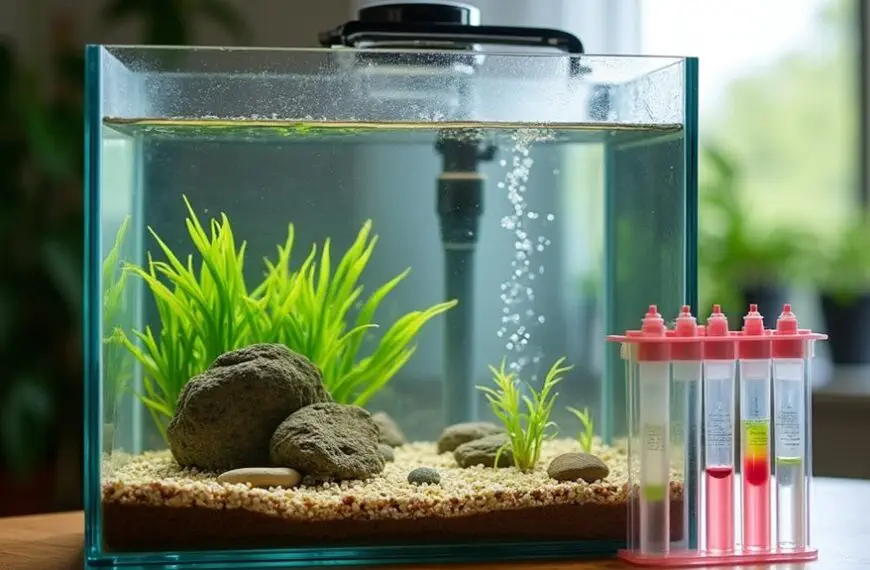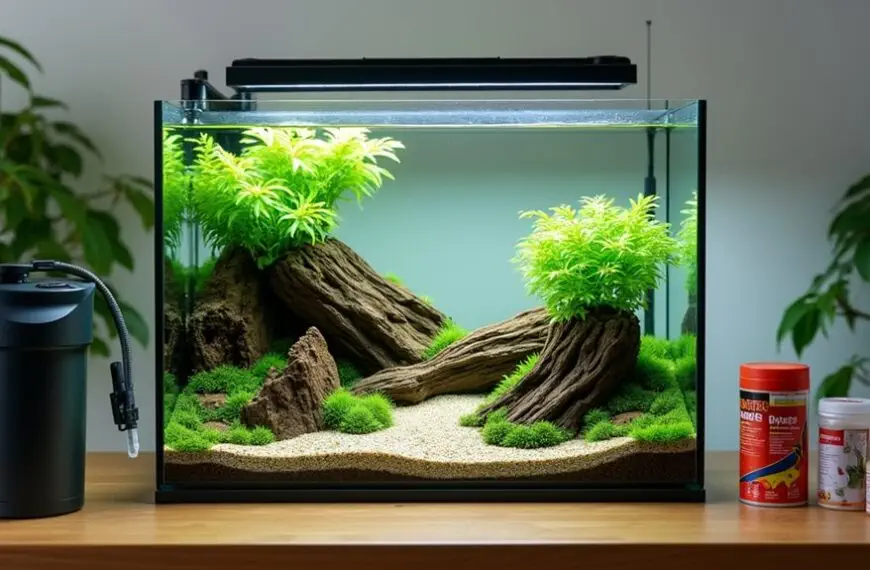Cycling a fish tank is super important because it sets up a healthy home for your fish. This process helps establish beneficial bacteria that transform toxic ammonia from fish waste into safer substances. If you skip cycling, your fish can suffer from ammonia poisoning, leading to stress and, in the worst case, even death. Plus, rushing into fishkeeping can result in "New Tank Syndrome," which nobody wants! Cycling typically takes about 4 to 8 weeks, so patience is key. Once you get your tank cycling right, your fish will thank you! Stick around to discover more about keeping your aquarium thriving.
Contents
- 1 Understanding Aquarium Cycling
- 2 Importance of the Nitrogen Cycle
- 3 Effects of New Tank Syndrome
- 4 Fishless vs. Fish Cycling
- 5 Monitoring Water Parameters
- 6 Required Equipment for Cycling
- 7 Common Mistakes to Avoid
- 8 Signs of a Successful Cycle
- 9 Long-term Maintenance Strategies
- 10 Frequently Asked Questions
- 11 Final Thoughts
Understanding Aquarium Cycling
How do you ensure a healthy environment for your fish? Understanding aquarium cycling is key. This essential process establishes beneficial nitrifying bacteria in your tank, which transforms toxic ammonia from fish waste into less harmful nitrite, and finally into nitrate.
Think of it as your fish's personal waste management service!
The nitrogen cycle usually takes four to eight weeks, depending on factors like tank size and temperature. You want to keep your pH between 7.0 and 7.8, ideally around 83°F to 87°F.
During this time, you'll need to regularly test water parameters using test kits. Watching those ammonia and nitrite levels drop to zero means you're on the right track!
It's like a scoreboard showing your progress toward a safe environment for your aquatic friends.
Importance of the Nitrogen Cycle
Establishing a thriving aquarium relies heavily on the nitrogen cycle, which transforms harmful substances into manageable compounds. This cycle's importance can't be overstated, as it converts toxic ammonia from fish waste into less harmful nitrite and then into nitrate, which you can control through water changes or plant absorption.
Here's why the nitrogen cycle is essential for your aquarium:
- Removes toxins: It helps eliminate toxic ammonia and nitrite, keeping your fish safe.
- Supports beneficial bacteria: Nitrifying bacteria like Nitrosomonas and Nitrospira work tirelessly to filter your tank water.
- Provides a stable ecosystem: A completed nitrogen cycle means undetectable ammonia and nitrite levels, signaling a healthy environment for your fish.
Cycling your tank usually takes 4 to 6 weeks, so patience is key. You might be tempted to speed things up with bottled bacteria, but natural cycling is generally the most reliable.
Effects of New Tank Syndrome
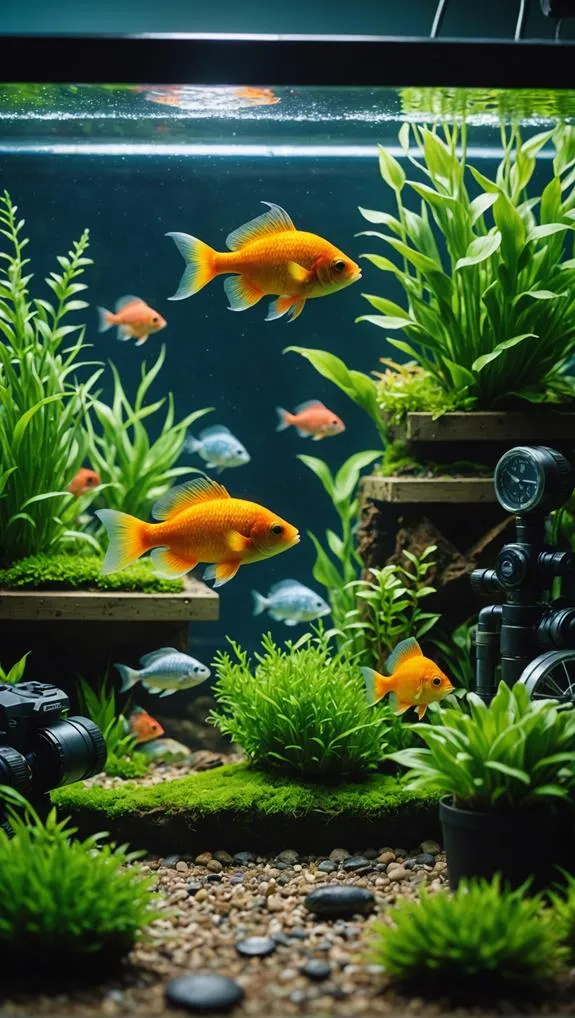
When you set up a new fish tank, you mightn't realize the trouble that can brew if it's not properly cycled.
New Tank Syndrome can sneak up on you, causing your fish stress and even illness due to toxic ammonia and nitrite levels.
But don't worry—in understanding the causes and using some simple prevention strategies, you can create a safe and happy home for your aquatic friends!
Causes of New Tank Syndrome
New Tank Syndrome's primary cause lies in the lack of beneficial nitrifying bacteria essential for converting harmful ammonia and nitrite into less toxic nitrate. When you set up a new aquarium, the balance isn't there yet, leading to potential problems for your fish buddies.
If you add too many fish too quickly, the organic waste can overwhelm the biofilter, causing dangerous spikes in ammonia and nitrite levels.
Here are some key points to understand:
- Tanks under six weeks old are especially vulnerable to New Tank Syndrome.
- Symptoms can include fish stress, erratic swimming, and lethargy.
- Ammonia poisoning can lead to fatalities in severe cases.
To create a stable environment, it's crucial to let your nitrifying bacteria establish themselves first.
You can mitigate the risks by slowly introducing fish and starting with small, hardy species. This way, your biofilter has time to adapt to the increasing bioload.
Think of it as giving your fish a warm welcome instead of a chaotic surprise party! By taking these steps, you're not just cycling a tank; you're ensuring a happier, healthier home for your aquatic friends.
Prevention Strategies for Success
Three key strategies can help you prevent New Tank Syndrome and ensure a thriving aquarium environment.
First, make sure to cycle the tank properly before adding fish. This means establishing beneficial bacteria that convert harmful ammonia levels into less toxic nitrates. Patience is key here, so don't rush it!
Second, always stock your fish slowly. Introduce only a couple of hardy species at first. This way, your biofilter can keep up with waste without getting overwhelmed. Remember, your fish are counting on you to create a safe home!
Lastly, invest in a good test kit to monitor the ammonia and nitrite levels regularly. This will help you catch any spikes early.
If you notice higher than normal ammonia levels, don't panic! Just perform regular water changes to keep things stable while your tank matures.
Fishless vs. Fish Cycling
Cycling an aquarium is essential for establishing a healthy environment for your fish, and there are two primary methods to achieve this: fishless cycling and fish cycling.
Fishless cycling is like a safety net for your aquatic friends. You add ammonia without fish, allowing beneficial nitrifying bacteria to grow without risking toxic spikes. It usually takes about 4 to 8 weeks, but it's a stress-free way to set up your tank.
On the other hand, fish cycling involves actual fish creating ammonia from their waste. This method can be riskier since it can lead to "New Tank Syndrome" if fish are added too fast before the biofilter is fully established.
Here are some quick points to consider:
- Fishless cycling provides a controlled environment to monitor ammonia levels.
- Fish cycling can work if you're diligent about water changes and keep ammonia levels below 0.2 ppm.
- A healthy biofilter is crucial for both methods, but fishless cycling generally results in less stress.
Ultimately, choose the method that suits your situation best. Your fish will thank you for it!
Monitoring Water Parameters

Monitoring water parameters is vital during the cycling process to ensure a safe environment for your fish. You'll want to keep a close eye on ammonia levels, nitrite levels, and nitrate levels.
When beneficial bacteria start doing their thing, ammonia levels should ideally be at zero. However, don't be surprised if they peak between 0.25 ppm and 4 ppm at first. Think of it as a rollercoaster ride for your aquarium!
Once ammonia is converted, you'll notice elevated nitrite levels. The cycling process is complete when both nitrite levels drop to zero and you can detect nitrates. This means the nitrogen cycle is working, and your fish can finally swim without worry.
Also, maintaining stable pH levels between 6.5 to 8.5 is crucial for those helpful nitrifying bacteria. Regularly testing with liquid kits gives you the most accurate readings on your water parameters. Trust me, those strips can be tricksters!
Required Equipment for Cycling
Setting up your aquarium for the cycling process requires some essential equipment to ensure a successful transition to a healthy environment for your fish. Without the right tools, your tank might face some serious ammonia drama.
Here's what you'll need:
- A quality water filter, preferably reverse osmosis, to maintain optimal water conditions and support beneficial bacteria growth.
- An aquarium test kit to regularly monitor ammonia levels, nitrite, and nitrate, which helps track your cycling progress.
- De-chlorinated water to prevent chlorine from wiping out those all-important nitrifying bacteria.
Don't forget about fish food! It serves as an ammonia source, providing nutrients to kickstart the nitrogen cycle as it decomposes.
If you want to speed things up, optional products with live nitrifying bacteria can help, but remember, you can still achieve proper cycling naturally.
Common Mistakes to Avoid
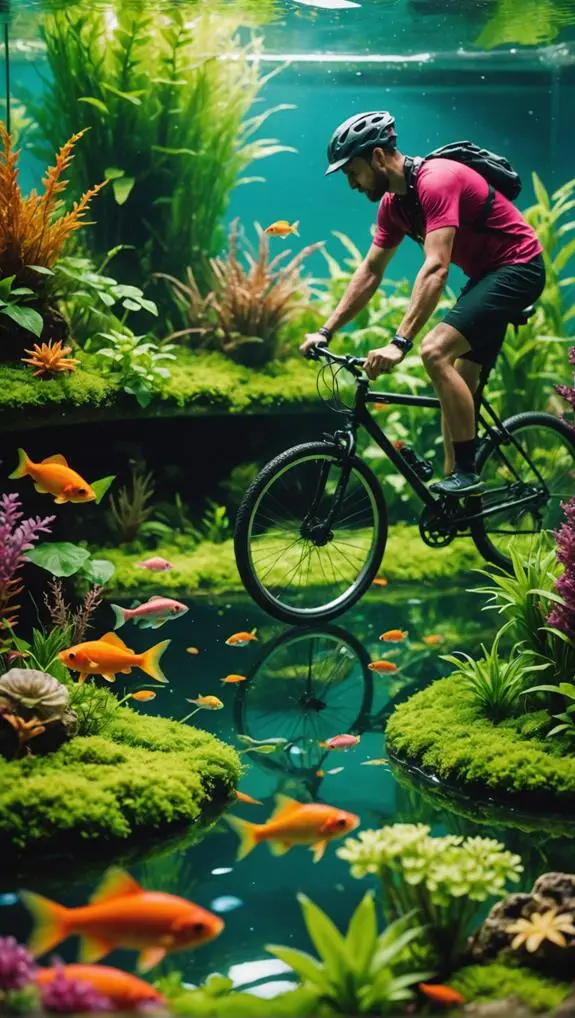
When you're setting up your fish tank, it's easy to make a couple of rookie mistakes.
Overloading your tank with fish too soon can lead to some serious ammonia spikes, and nobody wants to deal with that mess!
Plus, if you're not testing your water regularly, you might miss those sneaky toxins that could harm your fish friends.
Overstocking Fish Prematurely
Often, new aquarium owners underestimate the risks of overstocking fish prematurely, which can lead to serious issues like New Tank Syndrome.
When you add too many fish too quickly, it overwhelms your biofilter, leading to toxic ammonia and nitrite levels that can harm or even kill your fish. No one wants that!
To keep your aquatic friends safe, remember these key points:
- Introduce fish gradually: Add a few at a time to give beneficial bacterial colonies a chance to grow.
- Watch your bioload: More fish means more waste. Too much waste can upset the balance in your tank.
- Follow the one inch per gallon rule: This guideline helps prevent overstocking and keeps your ecosystem stable.
Immature tanks (those under six weeks old) are especially sensitive to water quality fluctuations.
Be patient; cycling your aquarium is essential. It might take four to eight weeks for your filter to adjust to the new bioload.
Ignoring Water Testing
Water quality is the lifeblood of your aquarium, and ignoring regular testing can spell disaster. You might think the cycling process is all about adding fish and watching them swim, but it's way more complex than that.
Daily water testing for ammonia levels and nitrite levels is crucial to track the progress of the nitrogen cycle. If you skip this step, you could end up with toxic levels that threaten your fish's health, leading to New Tank Syndrome.
Many new aquarists assume they can just test sporadically and call it a day, but that's a dangerous game. Consistent monitoring is key until both ammonia and nitrite levels reach zero.
Trust me, you don't want to misjudge your water chemistry and accidentally overstock your tank or introduce fish too early.
Signs of a Successful Cycle
A successful cycle in your fish tank can be recognized by several key indicators.
When you consistently test your water, you should see ammonia and nitrite levels reading zero. This means those hardworking beneficial bacteria are effectively processing waste products.
The real magic happens when you notice nitrates stabilizing, showing that your aquarium's environment is ready for fish.
Here are some signs to look for:
- Zero ammonia and nitrite levels during water testing.
- Stable nitrate levels, indicating a balanced cycle.
- New growth in aquatic plants, which help absorb excess nitrates.
These indicators mean your biological filtration system is doing its job, creating a safe space for your future finned friends.
Plus, healthy plants add beauty and stability, making your tank even more inviting.
Long-term Maintenance Strategies
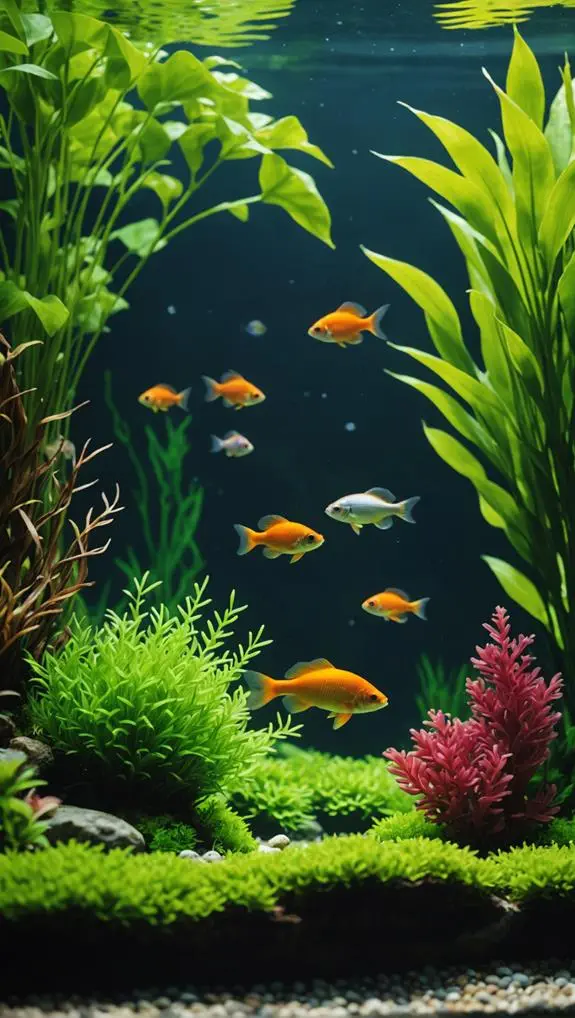
Maintaining a successful fish tank doesn't stop with achieving a stable cycle; it requires ongoing attention and care. Regular water testing is crucial. You'll want to keep your ammonia levels and nitrite at zero, while monitoring nitrate levels to stay below 20-40 ppm. This helps create a thriving ecosystem where your fish can flourish.
Performing routine water changes—about 10-20% each week—dilutes those pesky nitrates and replenishes important trace elements. It's like giving your fish a refreshing spa day!
Be mindful of your fish load too; adding fish gradually allows beneficial bacteria to adjust, ensuring your biofilter can handle the waste without stress.
Don't forget about biological filtration! High-quality filter media filled with established nitrifying bacteria is the backbone of waste processing. It reduces toxic buildup, keeping your tank safe.
Also, keeping an eye on water temperature and pH levels—between 75-80°F and 6.5-7.8—is vital for fish health and beneficial bacteria growth.
In short, consistent care keeps your tank cycle stable and your fish happy. A well-maintained tank is a beautiful, serene place, and you're the hero making it possible!
Frequently Asked Questions
Is Cycling a Fish Tank Necessary?
Yes, cycling a fish tank's necessary. It establishes beneficial bacteria, maintains water quality, and controls ammonia levels. Proper cycling methods reduce fish stress, ensuring compatibility and successful tank maintenance during the critical cycling duration.
How Long Does a Tank Need to Cycle Before Adding Fish?
Most tanks cycle between four to eight weeks. Monitor ammonia levels closely and watch for cycle completion indicators like stable nitrate levels. Use fishless cycling methods for beneficial bacteria growth, considering tank size and filtration system importance.
Can You Put Fish in a Tank Without Cycling?
You shouldn't put fish in a tank without cycling. Without beneficial bacteria, ammonia levels spike, causing fish stress. Proper filtration systems and bio load management ensure tank stability and help maintain the ecosystem balance and chemical composition.
How Do You Know if Your Aquarium Is Cycled?
Is your tank ready for fish? You'll know it's cycled when ammonia levels drop to zero, beneficial bacteria thrive, and water testing shows nitrates present. Regular filter maintenance ensures aquarium health, reducing fish stress significantly.
Final Thoughts
In a nutshell, cycling your fish tank is like laying the foundation of a cozy home for your aquatic friends. It keeps harmful toxins at bay and ensures a healthy environment. By understanding the nitrogen cycle and avoiding common mistakes, you'll be well on your way to a thriving aquarium. Remember, patience is key! With a little time and care, you'll create a vibrant underwater world that's as lively as a dance party for your fish.


